1999-2004 (Return to Web Text-ures) |
Click Here to return to |
1999-2004 (Return to Web Text-ures) |
Click Here to return to |
The counting-rooms of H.
C. Thacher & Co. were at 13 Central Wharf before the days when Fort Hill had
been dumped into the sea to form a part of Atlantic Avenue. Many of the boys of
Boston used to prowl around this wharf and those near by, to see their fathers'
vessels from foreign ports discharge their cargoes. Another interesting event
was to see the Yarmouth and Cape Cod packets tie up to their docks, which were
directly opposite the office of the Thachers. H. C. Thacher was born at directly
opposite on the Cape in 1829, at a time when most of the people of Cape Cod drew
their livelihood from the sea. At one time he used to tell his family that
he knew over fifty
sea-captains who lived along the main street of Yarmouth within a distance of
less than two miles.
He organized his firm in
1852 and for almost half a century he was engaged in the Mediterranean trade.
There is not a Cape Cod family that has not had its sea tragedy as well as its romance, and the Thacher family was no exception. There were two brothers in Yarmouth, called Bartlett and Chandler Thacher. Bartlett was only thirteen years old when he shipped as cabin boy on H. C. Thacher's bark "Mimosa," which plied between Boston and Smyrna and which was captained by a live Yankee skipper named Hall. She was a clipper, and her captain used to crowd on all the sail he could. Bartlett made his first trip to Smyrna and returned safely to Cape Cod and was on the point of sailing on his second trip to the same port. On the very day that he was to leave, his younger brother, Chandler, who was only ten years old, was drowned while playing at the Yarmouth wharf. Word was immediately sent to Bartlett, who was already aboard his vessel at East Boston, to give up sailing, but there was some delay in delivering the message and the "Mimosa" had already put to sea. She made a fast trip to Smyrna and with a large cargo on board started as usual on her homeward voyage. This was her last trip, as neither the vessel nor any of the crew were ever heard of again. The two nephews, Thomas Chandler Thacher and Lewis Bartlett Thacher, who are living in Boston to-day, were named after their uncles, who died so tragically in their youth.
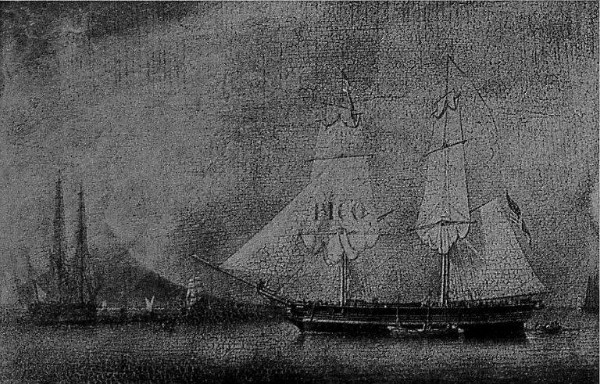
This house traded to a
large extent with Sicily and Italy, bringing home quantities of oranges and
lemons, as well as macaroni and sulphur. It is surprising that Boston got as
good fruit as it did in those days when one reads in the log books that some
vessels took thirty days to come from Gibraltar. The firm also imported hemp
from Russia, sending ships to Riga on the Baltic, and in the summer season to
the port of Archangel, on the White Sea; logwood, indigo, and tortoise shell
from Honduras; and from Fayal, through their relatives, the Dabneys, wine,
fruit, and whale oil, the latter commodity being left at that port by Nantucket
and New Bedford whalers. The firm also traded with the West Indies, Central and
South America, and Cape Town, and during the later years imported teas from
China.
Both partners were men of
very methodical business methods and were at their counting-room at seven
o'clock in the morning, which was the custom of the day; in fact, they were
typical representatives of the old-time merchants. The late Aaron Sargent, in a
recent paper read before the Boston Society, on the old merchants of Boston,
described Andrew and Charles as "dignified and severely polite." After the
"Beacon" was removed and Beacon Hill was dug down to make room for the new State
House, Mt. Vernon Street was laid out, and here were the residences of both the
Cunninghams, Andrew residing at No. 25, behind the State House, and Charles at
No. 48, near Walnut Street.
Many fine vessels were owned or managed by these two merchants, including among others the ships "Morea," "Adrian," "Helen"; the barks "Francia," "Matilda," "Adelaide Metcalf," "Elizabeth Leavitt," "Fame," and "Peru"; the brigs "Spartan," "Boston," "Swiftsure," "Wave," and "Pico," the latter being shown in a cut on the opposite page.
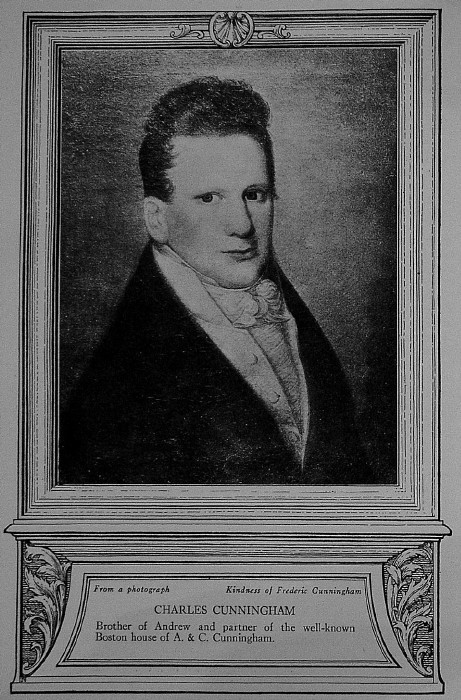
From a photograph
Kindness of Frederic Cunningham
CHARLES CUNNINGHAM
Brother of Andrew and partner of the well-known Boston house of A. & C. Cunningham.
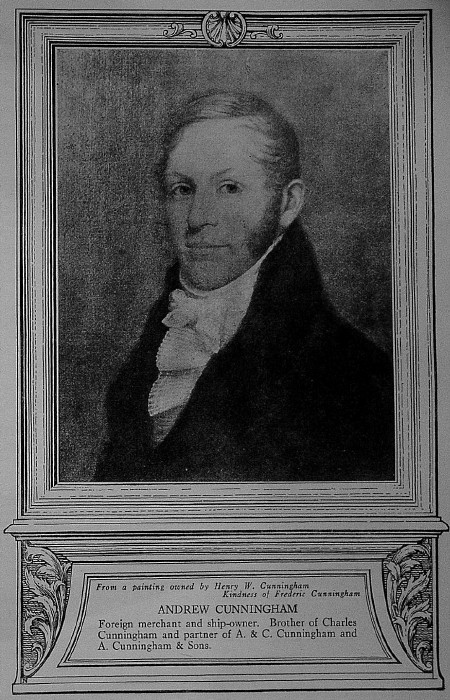
From a
painting
owned by
Henry
W. Cunningham
Kindness
of Frederic Cunningham
ANDREW CUNNINGHAM
At the time of the death
of Andrew Cunningham, in 1861, Captain John Codman, who had sailed many voyages
for him, wrote a letter to a Boston paper, in which he paid warm tribute to his
ability and sterling character, relating also the following incident in his
career. Long before the days of cables, when much of the business in foreign
ports was transacted by the captains, John Codman was about to set sail for
China with a large cargo, and, as much money had recently been lost by Boston
merchants in importing tea, he was especially instructed not to invest in a
pound for his return cargo. When the ship arrived in China conditions had so
changed that tea seemed like the most promising purchase, and Captain Codman
loaded his ship entirely with that product. When he arrived in Boston his cargo
of tea showed a handsome profit, but Mr. Cunningham nevertheless called the
captain into his private office and severely reprimanded him for disobeying
orders. As he left the office, however, the old gentleman remarked that the
voyage had been a successful one and handed Captain Codman, to his great
surprise, an envelope containing a check for $1,000.
Another one of the
Cunningham captains was Jonathan Edwards Scott, who was well known in Boston. It
is related of him that on one of his voyages to Boston he had lost both his
anchors, and was afraid that any towboat which he took to bring him in might
claim salvage, so he piled a lot of rubbish in the bows to hide the deficiency,
and when the towboat hailed him and asked if he wanted a tow, he said he guessed
not, adding that he thought he could sail up. "Well," said the towboat captain,
"I'm going up anyway, and may as well take you up," and he named a very small
sum. "All right," said Captain Scott, and threw out his line. When nearing the
city the towboat hailed him to know where he wanted to anchor. Captain Scott
replied, "Put me right in at Rowe's Wharf," which was done, and the captain
thereupon paid his towage and took a receipt in full. Upon leaving the ship the
towboat captain saw she had no anchors, and said, "Where are your anchors,
Captain?" and when Scott told him he had lost them the other exclaimed "Good
Lord, Captain, if I had known that, I would not have towed you up for less than
$500."
In 1849 Charles Cunningham
retired from business, and, as his brother's two sons, James Henry and Charles
West Cunningham, had grown up and were ready to take a hand in the business, the
younger members of the family were admitted as partners, the firm name being
changed to A. Cunningham & Sons. At about the same time Charles Cunningham's
son, named Frederic, formed a partnership with his cousin. Charles W. Dabney,
Jr., under the name of Dabney & Cunningham, with offices at 59 Commercial
Wharf, taking over a part of the business which the other firm had transacted
with the Western Islands. Their vessels included "Harbinger," "Pomona,"
"Grampus," "Melita," "Io," "Mermaid," "Lotos," "Azor," "Fredonia," and
"Newsboy." Still another firm was Cunningham Brothers, which was composed of
two nephews of Andrew and Charles Cunningham, John A. and Loring Cunningham,
brothers of the late Edward Cunningham, who was an eminent merchant of China,
and partner of Russell & Co. Mr. Edward Cunningham's place was in Milton, and
the children thereabout were wont to wonder at the great Chinese dragons which
served as gateposts at the entrance to his driveway. They were brought from
China, were sunk on the way, but were recovered with great difficulty and landed
in this country.
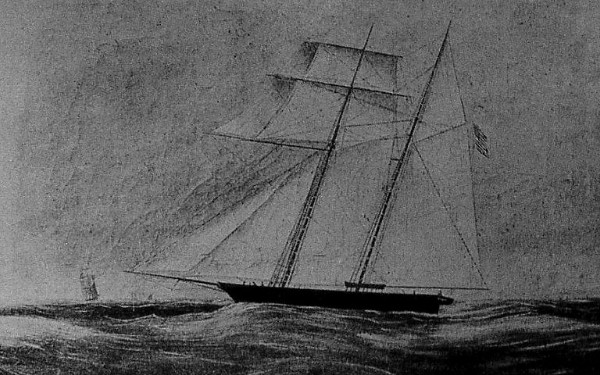
From a painting
Kindness of Chester Guild
THE KING'S YACHT
This graceful Yacht was called "Kamehameha III,"
after one of the rulers of Hawaii and as fitted out by him as a man of war. She
was sailed out to the Sandwich Islands by Captain Fisher A. Newell of Boston,
and was captured by the French a few year, later. She was the Pride of Hawaii,
and was called "Kammey" by the islanders. The painting from which
this picture is taken was brought,
ion, Honolulu to Boston by Captain Richard Mitchell of Nantucket, who landed at
the Islands to ship home sow, whale oil. Captain Mitchell gave the Painting to
his son-in-law, Sell, A. Fowl,, who had it hung h, his office for many years. It
then descended to his cousin, Chester Guild, and it was through his kindness
that it was possible to obtain this photograph. The studding sails on the
foretop and foretop gallant yard are very unusual. Her Boston owners were Deming
Jarvis, Benjamin Howard, and John D.
Lambree.
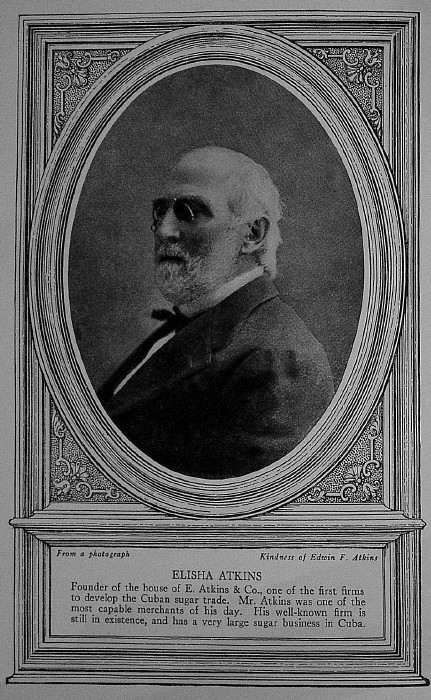
From a photograph
--Kindness.
of
Edwin F. Atkins
Founder of
the house of E.
Atkins &
Co.,
one of the first firms to develop the Cuban
sugar trade. Mr. Atkins was one of
the most capable merchants of his
day. His well-known firm is still in existence, and has a very large sugar
business in Cuba.
Elisha Atkins started in
the Cuban business for himself in 1835. In 1866, John W. Cummings, who had been
his chief clerk for many years, was taken into partnership, forming the firm of
P:. Atkins & Co. The senior member, Mr. Atkins, was taken when a boy from Cape
Cod, where the family had lived since 1639, to Roxbury, where his parents hoped
there would be less chance of his being tempted to go to sea. In spite of this
precaution he entered the office of Dennis
Brigham on Rowe's Wharf,
and went out as supercargo to Caracas on one of his employer's vessels, a few
years later going into the sugar business for himself.
In 1837, during the panic
brought on by the failure of the United States Bank, his business was
unprofitable. The following year the firm of Atkins & Freeman was formed,
William F. Freeman being admitted as partner. The firm had offices on India
Wharf, its neighbors being Thomas Wigglesworth, W. F. Cunningham R Co., George
T. Lyman, Bullard C Lee, the Higginsons, R. B. Storer, W. Windsor Fay, E. A.
Homer, B. Burgess, Minot, & Hooper, Boardman & Pope, all well-known merchants of
their day. To those offices the rich planters came, and then spent their money
at Saratoga Springs, and along the wharves could be seen cargoes from all parts
of the globe. Here also were the consulates of Sweden, Norway, Belgium, and
Russia. "Here," as described by William Howell Reed, who wrote the life of Mr.
Atkins, "were the quaint old offices with their ancient furniture, the blazing
open fires in winter, the pictured walls with ship; sailing in every ocean, the
models of favorite vessels, the courtly manners of the old merchant princes of
that day, the counting-house decorum, the quiet respectability, the aroma of the
lofts above packed with the merchandise of the East."
R. G. Shaw & Co. once
joined Mr. Atkins in making up a cargo on one of the earlier voyages, while
Joshua Scars, one of the large retail purchasers of sugar in Boston, assisted
occasionally in times of tight money. The first shipment to Cienfuegos was in
1843, at which port Columbus landed on his first voyage. There was little going
on here at this time, Trinidad being the centre of business and society; but
gradually this port grew, owing to the large amount of business transacted there
by Mr. Atkins and Mr. Benjamin Burgess. In these early days the mills were run
by oxen and were called "Bull Mills." Mr. Atkins's letters home give a good idea
of the life on the plantations. One letter describes a night spent on top of
some sugar-boxes on board a very small vessel, while another one mentions his
disgust on seeing for the first time a very pretty Cuban girl light a large
cigar.
In 1849 Mr. Atkins again
conducted business alone, Mr. Freeman retiring. The business, however, continued
to prosper, and his vessels visited not only Cuba, but the Windward Islands, St.
Thomas, Jamaica, Guatemala, and occasionally Rio Janeiro. Boston now became a
great sugar market. John S. Emery, ship owner and broker, chartered over four
hundred vessels to Mr. Atkins. It was at this period (1866) that Mr. Cummings
was admitted to partnership.
Some of the vessels owned
were the well-known "Adelaide," "Chatham," "Marine," "Tom Corwin," "W. B.
Stetson," "Jacinta," "Clotilde," and "Neptune," the latter being the favorite
ship. A few of the shipmasters in whom Mr. Atkins took a great interest were
Captains Burt, Bassford, Harding, and Beal.
Mr. Edwin F. Atkins, the
son of the founder of the business, was admitted to partnership in 1874, and is
now the head of this well-known
house, conducting the business with his son, Robert W. Atkins, who was taken
into the firm in 1915, being the third generation in a business of over eighty
years' standing, as commission merchants, planters, manufacturers, and refiners.
The Bay State Sugar
Refinery of Boston, owned and operated by E. Atkins & Co. for many years,
entered the consolidation which comprised many of the sugar refineries of the
United States, then known as The Sugar Refineries Company, just before the death
of Elisha Atkins in 1888; and Edwin E. Atkins later became prominent in the
management of its successor, the American Sugar Refining Company.
Elisha Atkins was
considered one of the most capable merchants of his day. He was one of the
builders of the Union Pacific Railroad and active in its management up m the
time of his death. He was also connected with many enterprises, both in New
England and throughout the West.
Enoch Train was so popular
with his employees that when he failed during one of the panics prior to the
Civil War, one of his Portuguese stevedores, taking his own bank book, placed it
on his employer's desk, saying, "Take it; I have made the money out of your
ships." This anecdote well illustrates the fine relations that existed between
himself and his employees, to whom he was always kind and considerate. He was
likewise the soul of honor and integrity, and was generous and public-spirited
in every worthy cause. Aaron Sargent in his "Recollections of Boston Merchants"
best describes his popularity: "To receive a bow or a 'Good-morning' salute from
Enoch Train, as, tall and erect and with manly step, he walked down State Street
and along Commercial Street to his counting-room, was something not to be
despised by any one, whether a merchant or one holding some other position in
commercial Boston." He was also foremost among the merchant ship-owners of his
day, and at one time owned the largest number of ships of any firm in Boston,
thirty or more of his vessels plying between this port and Liverpool. Having
been brought up in the hide and leather store of his uncle, Samuel Train, his
earliest ventures after he went into shipping
on his own
account were in the Russian and South American trades, importing principally
hides. A few years lacer, in 1844, he established the well-known Train line of
packets to Liverpool, the first ship built being the "Joshua Bates," named after
the American partner of Baring Brothers at that time. This vessel was built for
him at Newburyport by the celebrated ship-builder, Donald McKay. Mr. Train was
so much pleased with this first vessel and with the skill of the builder that on
the day she was launched he said to McKay, "You must come to Boston; we need
you, and if you want any financial assistance in establishing a shipyard let me
know, the amount and you shall have it." The rest is too well known to repeat.
In rapid succession were launched the "Anglo Saxon;" "Anglo American,"
"Washington Irving," ''Ocean Monarch," "Parliament," "Star of the Empire,"
"Chariot of Fame," "Staffordshire," "Cathedral," and "John Eliot Thayer." The
"Staffordshire " was lost at sea not far from this coast and many passengers
were lost. It is stated that there were so few boats and panic-stricken people
clung so desperately to the gunwales of the rowboats that one of the officers
was obliged to chop off their fingers with a hatchet in order to save even a few
of the passengers. Another ship, the ''Ocean Monarch," was bullied at sea with a
loss of four hundred lives, and George Francis Train, a representative of the
firm, in an account of his life, describes the pathetic scene he witnessed when
the news was first announced in Boston. It was customary for the captain of each
inward-bound vessel as she approached her dock to shout from the rail the latest
news. On this occasion the "Persia" under Captain Judkins was about to dock, and
hundreds of people were waiting to hear tidings of some friend or vessel. The
captain shouted the sad fate of the "Ocean Monarch'" and within a few minutes
the announcement was made in the Merchants Exchange. The Train firm on another
occasion believed the "Gov. Davis," which ran on their Boston, New Orleans,
Liverpool triangular route, had also been burned at sea, as word was received
that "The 'Gov. Davis' is burned up." While those in the counting-house were
grieving over their losses of friends and cargo, another message was handed to
them, changing the message to "The 'Gov. Davis' is bound up." The vessel was
safe in Boston Harbour and there was great rejoicing in the Train office.
Another ship belonging to the firm, called "Break of Day," came into Boston
Harbour on a winter's day without a spar standing. "The Chariot of Fame" was
Train's favorite vessel, her master being Captain Knowles. She had a
reading-room on her quarter-deck for cabin passengers, a great luxury in those
days.
Donald McKay also built
for Mr. Train the "Flying Cloud," "Empress of the Seas," "Plymouth Rock," which
was half-owned by George B. Upton, and the "Lightning." Some of Train's captains
were Caldwell, Thayer, Murdock, Brown, Richardson, Howard, and Knowles.
In 1855 the Boston &
European Steamship Company was incorporated, with Enoch Train; George B. Upton,
Donald McKay, Andrew T. Hall, and James M. Beebe as sponsors, "for the purpose
of navigating the ocean by steam." The plan was to build a splendid line of
steamers, rivalling in every respect the well-known Collins line of New York,
the English port to be Milford Haven in Wales. The remarks made by Enoch Train
at that time are especially interesting to took back upon, as they show his
ideas in regard to the steamship which was then just beginning to replace the
sailing-ship. It had been expected that Train would oppose the suggested
company, as being antagonistic to his own, but instead he was so broad-minded
that he lent it the strength of
his right arm, as he expressed it.
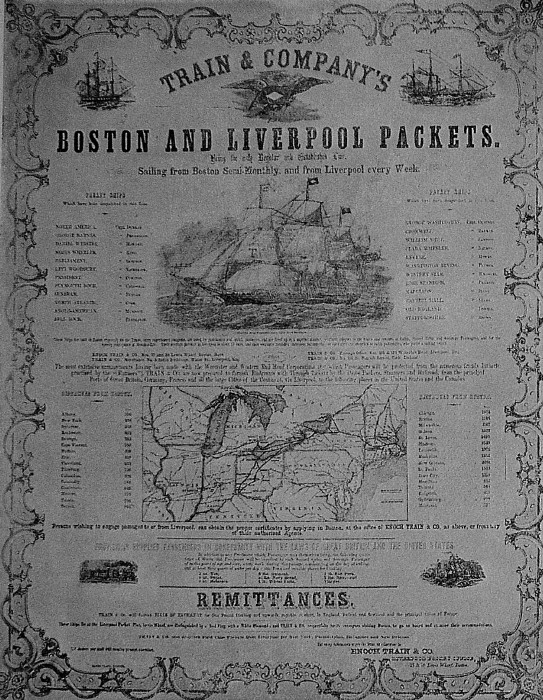
Photograph from an
original
Kindness of Stephen G. Train
TRAIN & CO.'S POSTER
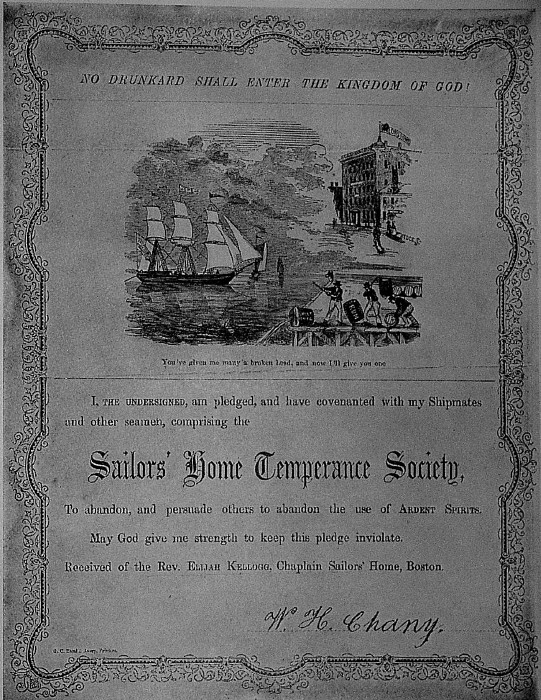
Kindness of J. Chany
PLEDGE OF THE SAILORS'
HOME TEMPERANCE SOCIETY
Showing the Sailors' Home, and men on the
wharf destroying barrels of rum. The remark, "You've given me many a broken
head, and now, I'll give you one," is amusing.
"There is a vast difference," he said, "between steam
and sailing vessels," and steam would not interfere with his regular business,
the transportation of coarse and weighty commodities, and passengers who could
not afford the luxury of steam passage. A large committee was appointed, but the
panic of 1857 put a stop to all plans.
Frederic W. Thayer, a partner at one time of Mr.
Train, established an office in Liverpool. Later he and Mr. George Warren
formed a partnership under the name of Thayer & Warren, succeeding to the
business of Enoch Train & Co. It a still later date the name was changed again
to the well-known firm of Warren & Co. This latter firm still flies the Train
private signal, a red ground with a white diamond, and was one of the first
houses to appreciate the commercial importance of iron screw steamers.
Enoch Train at first had his counting-house at 37
Lewis Wharf, and later, about 1852, he bought Constitution Wharf for the use of
his ships, moving his private office to State Street.
The two cuts as the frontispiece of this pamphlet
show in the first picture an Irishman in straitened circumstances carefully
examining one of Enoch Train & Co.'s shipping announcements of a sailing to
Boston; the second one depicts the same individual about to return from Boston
on the same line to the "Old Country," having become prosperous in the United
States.
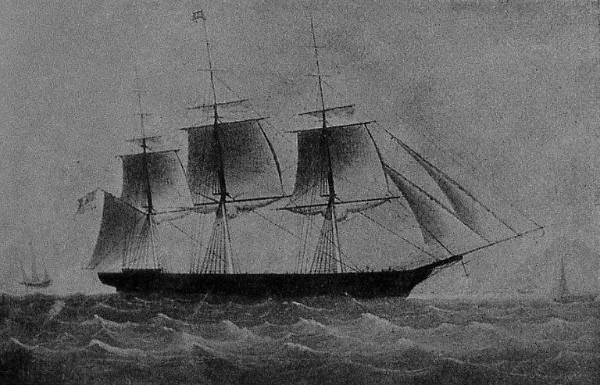
From a painting in
the Nantucket Library
THE "SAMUEL RUSSELL"
Named
after the founder of the house of Russell & Co., the largest of the American
firms in China. The "Samuel Russell" was built in 1846 for A. A. Low & Co., was
commanded for many years by Captain A. L. Palmer and was lost off the Cape of
Good Hope. She
was one of the
fastest
clippers of her day.
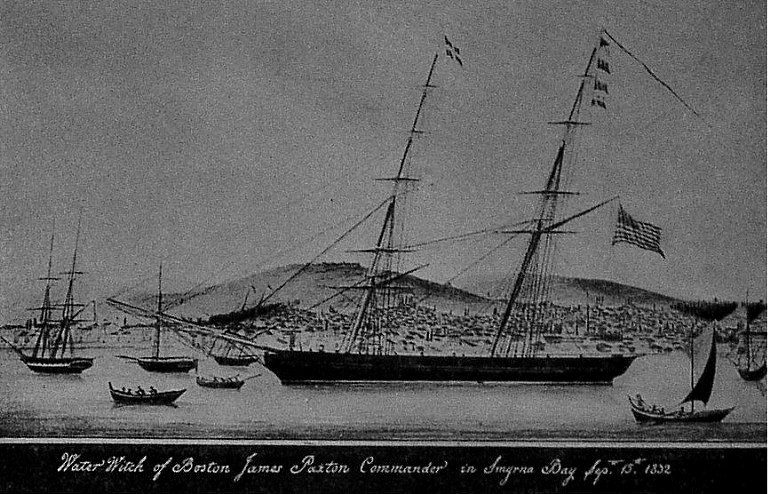
ONE OF THE BEST KNOWN SHIPS OF BENJAMIN C. CLARK & CO.
Captain Arthur H. Clark quotes Thomas Appleton as
Saying that no Boston family was quite Complete that could not claim at least
one retired sea-captain! and if one examines the names of Boston captains, one
finds that this statement has much truth in it. Captain Clark had many friends
in the same trade, and a list made by him furnishes further proof that Appleton
was right in his assertion. Robert Adams, of the "Rocket" and "Golden Fleece,"
was a son of the Rev. Nehemiah Adams; John Boote succeeded Captain William C.
Rogers in the "Witchcraft"; Robert Airily was captain of the "Nor' Wester";
Henry Sargent, of the "Rockland," "Phantom," and "Emily C. Starr," was an older
brother of Daniel and Prank Sargent and Mrs. Goodwin Whitney and Mrs. William
Appleton of New York; Captain Gannett, of the ship "Benares," was a younger
brother of the Rev. Dr. Gannett; Frank Haskell, who commanded the "Norseman,"
was an elder brother of Thomas and Frederick Haskell; Captain Frank Dale, who
sailed the "Fleetwood," was a brother of Dr. Dale, and uncle of Eben Dale and
Mary Dale, who married Colonel Charles Turnbull; Putnam Upton, of the "Dragoon,"
was a son of George B. Upton, the well-known ship-merchant; James Dwight, of the
"Cutwater" and "James Freeman Clarke," was a cousin of Howard and Wilder Dwight;
and Montgomery Parker, captain of the ships "Judge Shaw" and "Lord Lyndhurst,"
was a son of Richard G. Parker. All of these names and many more were, according
to Captain Clark, the pride of Boston, and will go down on the records of the
maritime history of the city.
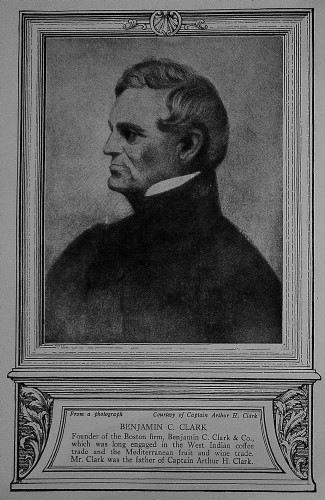
From a photograph Courtesy
of Captain Arthur H. Clark
Founder of the Boston firm, Benjamin C. Clark & Co., which was long engaged in
the West Indian coffee
trade and the Mediterranean fruit and wine
trade. Mr. Clark was the father of Captain Arthur H. Clark.
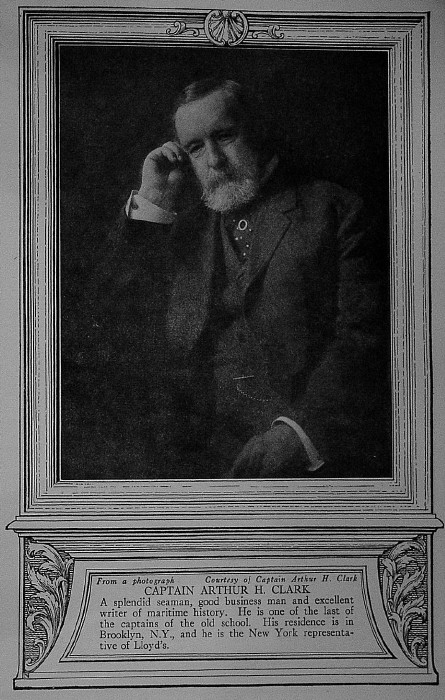
CAPTAIN ARTHUR H. CLARK
A
splendid seaman, good business man and excellent
writer
of maritime history. He is one of the last of the captains of the old school.
His residence is in Brooklyn. N.Y., and he is the New York representative of
Lloyd's.
Captain Clark, who is now Lloyd's representative
in New York, has an extraordinary record as a Boston shipmaster. His first
sailing experience was with small model yachts on the Frog Pond, which was
opposite his father's house, No. 36 Beacon Street, and later he learned to
navigate his father's yacht off Nahant. After leaving the Latin School he
determined to adopt the sea as his calling, and shipped before the mast on the
clipper "Black Prince" around the Horn to San Francisco, Manila, Foochow, and
other distant ports. When this ship returned, two and one-half years later, he
had been advanced to the position of third mate. He then became second officer
of the famous "Northern Light," returning to the "Black Prince " as chief mate.
In a short time he rose to be chief mate of the ship "J. C. Humphreys," then
master of the "Agnes," and the "Verena," in the China trade. His next adventure
was to command the yacht "Alice," only forty-eight feet long, on a voyage from
Boston to England, one of his companions being Mr. Charles Longfellow, son of
the poet. Up to this time this was the smallest yacht to cross the Atlantic and
the first American yacht to sail from America direct to England. Upon his return
to Boston, Captain Clark was appointed by J. M. Forbes &
Co. to
take the steamship "A. J. Ingersoll" to China. He subsequently commanded the
"Manchu," "Suwo Nada," and "Venus" in the China Seas, and received a service of
silver from American and British underwriters for his wonderful feat in bringing
the "Suwo Nada," owned by Augustine Heard & Co., into Hong Kong in such a
sinking condition that she sank in the graving dock before the gates could be
closed, having struck an uncharted rock on the Chinese coast. Captain Clark
subsequently commanded the American Mail S.S. "Indiana," between Philadelphia
and Liverpool, and retired from the sea in 1877, but made one more ocean voyage
in 1894-1895 when he brought the steam yacht "Sylvia," owned by Commodore
Edward M. Brown of the New York Yacht Club, from Queenstown to New York during
the months of December and January.
This yacht was 138 tons
gross. The "Alice" and "Sylvia" are the two smallest sailing and steam yachts
respectively that have crossed the Atlantic under the burgee of the New York
Yacht Club. Both made the passage in nineteen days.
Captain Clark is a very familiar figure of the
down-town shipping community of New York, and is one of the last of that fine
type of gentleman sea-captains of the old school. He is not only a splendid
seaman, but also a business man of sound judgment, and a writer of maritime
history of first importance. He is the son of Hon. B. C. Clark, who was the
founder of the firm of Benjamin C. Clark & Co. of Boston. This well-known house
from 1830 to 1848 owned a number of clipper brigs and topsail schooners which
were engaged in the West India coffee trade and the Mediterranean fruit and wine
trade, some of these vessels being the "SeaEagle," "Water Witch." "Silenus,"
"Red Rover," and "Sea Mew." Benjamin C. Clark built and owned the schooner yacht
"Mermaid," which was then -- 1832 -- the first decked yacht owned in Boston, and
a few years later he built the "Raven," which won the cup in the first regatta
sailed in Massachusetts Bay, at Nahant, on July 19, 1845.
| Oh, again
to hear the Lascars' rousing "chanty" in the morn,
When we broke away the anchor to sail home around the Horn! Oh, to see the white sails pulling, feel the lift beneath the keel, With the trade-mind's push behind her and the roll that. made her reel! The old Clipper days are over, and the white-winged fleets no more, With their snowy sails unfolded, fly along the ocean floor; Where their house-flags used to flutter in the ocean winds unfurled, Now the kettle-bellied cargo tubs go reeling around the world. But 'twas jolly while it lasted, and the sailor was a Man; And it's good-by to the Lascar and the tar with face of tan; And it's good-by mother, once for all, and good-by girls on shore; And it's good-by brave old Clipper-ship that sails the seas no more! |
(From Boston Transcript.)